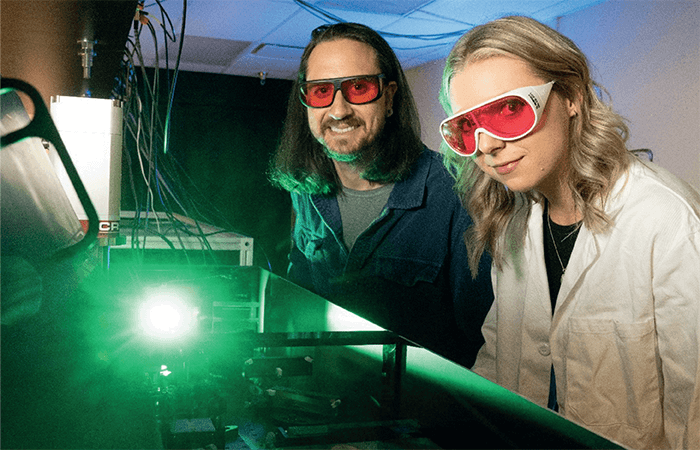Solar cell materials absorb a large fraction of sunlight, but a significant proportion of the energy is lost as heat rather than being converted to electricity. Seeking efficiency gains, researchers from Colorado State University (1) used an “unprecedented combination” of photoelectrochemical and in situ transient absorption spectroscopic measurements to probe a new solar cell material candidate. Their results show that “extremely thin films of molybdenum disulfide display unprecedented charge carrier properties” – and the team believe their finding could help “drastically improve solar technologies”... someday (2).
Rachelle Austin, lead author of this study, told us the research stemmed from a collaboration between Justin Sambur and Amber Krummel. “Sambur’s group had developed unique photoelectrochemical devices constructed specifically for in-operando optical measurements,” she says. “Meanwhile, Krummel’s lab used ultrafast transient absorption spectroscopy to measure electron dynamics on extremely short timescales.” As both groups share lab space at CSU, a classic water-cooler moment (we presume) led the groups to address a rather practical question: “Can we make measurements of these photoelectrochemical devices on the transient absorption spectrometer?”
As the groups started collecting data, they realized they needed a model to understand the dynamics, so recruited the essential computational services of Andrés Montoya-Castillo’s group – and so the collaboration grew.
According to Austin, Sambur’s group has been studying monolayer MoS2 for solar energy conversion applications – keen to make use of its unique electronic properties. “We expected that hot carrier extraction was occurring in monolayer MoS2 to cause the high photocurrents measured in the Sambur Lab,” says Austin. “By measuring the electronic dynamics with the Krummel Lab’s spectrometer, we thought we could determine the mechanism for charge extraction.”
The key finding? “Hot carrier extraction occurs in monolayer MoS2 – and it happens on an ultrafast timescale of less than 50 fs, which came as a surprise!” The work could help develop new solar energy technologies, says Austin – particularly, solar electrochemical fuel cells. “By extracting hot carriers before they cool, we can use 2D photoelectrodes to increase the efficiency of solar energy conversion by up to 33 percent. We can also use these materials to convert solar energy into fuels that can be stored and transported,” she adds.
But the team also knows that there is a long way to go before their devices become commercially available. “One big factor is the stability of 2D materials in water and air over time,” admits Austin. “And another challenge is the scalable production of the 2D photoelectrode material.”
When asked about the importance of analytical science in such research, Austin says, “Well it is essential! By providing insights into the electronic behavior and properties of 2D materials at the nanoscale, analytical techniques can inform the design of new solar technologies and facilitate our transition to a more sustainable energy future.” And she encourages others to join them in the hunt for more efficient – and greener – materials.

References
- R Austin et al., PNAS (2023). DOI: 10.1073/pnas.2220333120.
- Colorado State University, “Chemists propose ultrathin material for doubling solar cell efficiency” (2023). Available at: http://bitly.ws/HmML.




